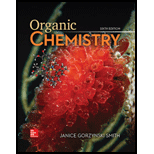
Concept explainers
(a)
Interpretation: The given pair of compounds is to be classified as enantiomers, epimers, diastereomers but not epimers or constutitional isomers of each other.
Concept introduction: Two compounds which are non-superimposable mirror images of each other are known as enantiomers, two compounds which are neither superimposable nor mirror images to each other are known as diastereomers and two compound in which the configuration of one of their stereogenic centers is different are known as epimers.
(b)
Interpretation: The given pair of compounds is to be classified as enantiomers, epimers, diastereomers but not epimers or constutitional isomers of each other.
Concept introduction: Two compounds which are non-superimposable mirror images of each other are known as enantiomers, two compounds which are neither superimposable nor mirror images to each other are known as diastereomers and two compound in which the configuration of one of their stereogenic centers is different are known as epimers.
(c)
Interpretation: The given pair of compounds is to be classified as enantiomers, epimers, diastereomers but not epimers or constutitional isomers of each other.
Concept introduction: Two compounds which are non-superimposable mirror images of each other are known as enantiomers, two compounds which are neither superimposable nor mirror images to each other are known as diastereomers and two compound in which the configuration of one of their stereogenic centers is different are known as epimers.
(d)
Interpretation: The given pair of compounds is to be classified as enantiomers, epimers, diastereomers but not epimers or constutitional isomers of each other.
Concept introduction: Two compounds which are non-superimposable mirror images of each other are known as enantiomers, two compounds which are neither superimposable nor mirror images to each other are known as diastereomers and two compound in which the configuration of one of their stereogenic centers is different are known as epimers.
(e)
Interpretation: The given pair of compounds is to be classified as enantiomers, epimers, diastereomers but not epimers or constutitional isomers of each other.
Concept introduction: Two compounds which are non-superimposable mirror images of each other are known as enantiomers, two compounds which are neither superimposable nor mirror images to each other are known as diastereomers and two compound in which the configuration of one of their stereogenic centers is different are known as epimers.
(f)
Interpretation: The given pair of compounds is to be classified as enantiomers, epimers, diastereomers but not epimers or constutitional isomers of each other.
Concept introduction: Two compounds which are non-superimposable mirror images of each other are known as enantiomers, two compounds which are neither superimposable nor mirror images to each other are known as diastereomers and two compound in which the configuration of one of their stereogenic centers is different are known as epimers.
Want to see the full answer?
Check out a sample textbook solution
Chapter 26 Solutions
EBK ORGANIC CHEMISTRY
- Identify the missing organic reactants in the following reaction: X + Y H+ two steps Note: This chemical equation only focuses on the important organic molecules in the reaction. Additional inorganic or small-molecule reactants or products (like H2O) are not shown. In the drawing area below, draw the skeletal ("line") structures of the missing organic reactants X and Y. You may draw the structures in any arrangement that you like, so long as they aren't touching. Click and drag to start drawing a structure. Х :arrow_forwardDraw the mechanism of friedel-crafts acylation using acetyl chloride of m-Xylenearrow_forwardI need help naming these in IUPACarrow_forward
- H R Part: 1/2 :CI: is a/an electrophile Part 2 of 2 Draw the skeletal structure of the product(s) for the Lewis acid-base reaction. Include lone pairs and formal charges (if applicable) on the structures. 4-7: H ö- H Skip Part Check X :C1: $ % L Fi Click and drag to start drawing a structure. MacBook Pro & ㅁ x G 0: P Add or increase positive formal cha Save For Later Submit ©2025 McGraw Hill LLC. All Rights Reserved. Terms of Use | Privacy Centearrow_forwardDraw the friedel-crafts acylation mechanism of m-Xylenearrow_forwardDon't used hand raiting and don't used Ai solutionarrow_forward
- 1. Base on this experimental results, how do you know that the product which you are turning in is methyl 3-nitrobenzoate(meta substituted product ) rather than either of the other two products? 2. What observation suggests that at least a small amount of one or both of the other two isomers are in the mother liquor?arrow_forwardExplain Huckel's rule.arrow_forwardhere is my question can u help me please!arrow_forward
 Chemistry In FocusChemistryISBN:9781305084476Author:Tro, Nivaldo J., Neu, Don.Publisher:Cengage Learning
Chemistry In FocusChemistryISBN:9781305084476Author:Tro, Nivaldo J., Neu, Don.Publisher:Cengage Learning Introductory Chemistry: A FoundationChemistryISBN:9781337399425Author:Steven S. Zumdahl, Donald J. DeCostePublisher:Cengage Learning
Introductory Chemistry: A FoundationChemistryISBN:9781337399425Author:Steven S. Zumdahl, Donald J. DeCostePublisher:Cengage Learning Chemistry & Chemical ReactivityChemistryISBN:9781133949640Author:John C. Kotz, Paul M. Treichel, John Townsend, David TreichelPublisher:Cengage Learning
Chemistry & Chemical ReactivityChemistryISBN:9781133949640Author:John C. Kotz, Paul M. Treichel, John Townsend, David TreichelPublisher:Cengage Learning World of Chemistry, 3rd editionChemistryISBN:9781133109655Author:Steven S. Zumdahl, Susan L. Zumdahl, Donald J. DeCostePublisher:Brooks / Cole / Cengage LearningChemistry: Matter and ChangeChemistryISBN:9780078746376Author:Dinah Zike, Laurel Dingrando, Nicholas Hainen, Cheryl WistromPublisher:Glencoe/McGraw-Hill School Pub Co
World of Chemistry, 3rd editionChemistryISBN:9781133109655Author:Steven S. Zumdahl, Susan L. Zumdahl, Donald J. DeCostePublisher:Brooks / Cole / Cengage LearningChemistry: Matter and ChangeChemistryISBN:9780078746376Author:Dinah Zike, Laurel Dingrando, Nicholas Hainen, Cheryl WistromPublisher:Glencoe/McGraw-Hill School Pub Co Introduction to General, Organic and BiochemistryChemistryISBN:9781285869759Author:Frederick A. Bettelheim, William H. Brown, Mary K. Campbell, Shawn O. Farrell, Omar TorresPublisher:Cengage Learning
Introduction to General, Organic and BiochemistryChemistryISBN:9781285869759Author:Frederick A. Bettelheim, William H. Brown, Mary K. Campbell, Shawn O. Farrell, Omar TorresPublisher:Cengage Learning





